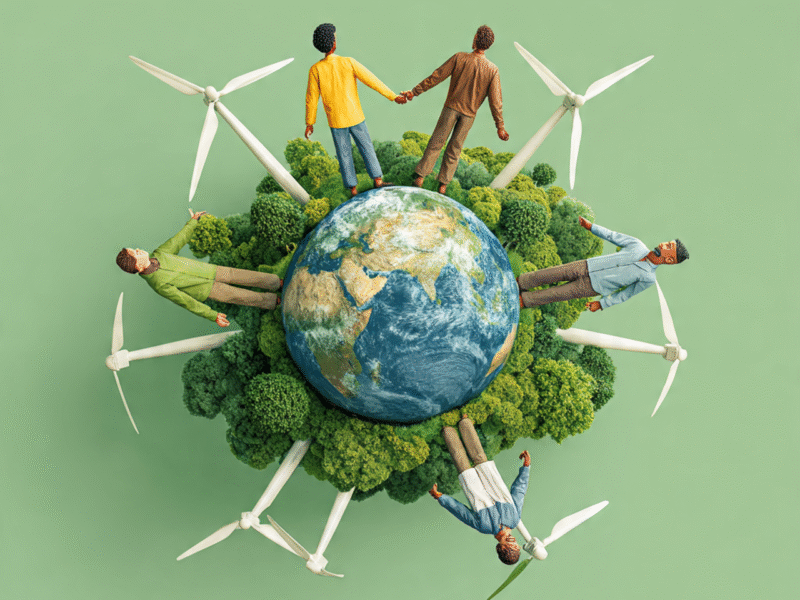
Today, I am presenting to you a unique and comprehensive piece on the integration of digital innovation and green technology, being written for the first time in the world. This writing will tell you how digital innovation, combined with green technology, is playing a revolutionary role in monitoring emissions, protecting biodiversity, and shaping global policies. If you like this material, please let us know, and if you need more details on any specific topic, you can contact us.
🌐 The Integration of Digital and Green Technology: A New Era of Environmental Protection
The mutual integration of digital innovation and green technology is emerging as the most powerful force for environmental protection in today’s era. This trend is not merely a combination of two technologies but is a transformative force opening new pathways to secure our planet’s future. When we consider the fusion of these two fields, we find that digital technologies like Artificial Intelligence, the Internet of Things, Blockchain, and Big Data Analytics are presenting solutions in concert with green technology that were never before possible. For example, AI-powered monitoring systems can now detect carbon emissions in real-time, IoT sensors can continuously monitor water and air quality, and blockchain technology can ensure supply chain transparency. These developments truly mark the beginning of a new era where digital solutions are at the heart of solving environmental problems.
This integration of digital and green technology has revolutionized the field of environmental monitoring. Unlike traditional methods, which were expensive, time-consuming, and limited, modern digital solutions have made environmental data collection and analysis affordable, efficient, and comprehensive. NASA’s satellites, the European Space Agency’s Copernicus Program, and private companies like Planet Labs’ cubesats now provide daily high-resolution imagery of the Earth. This data is processed by AI algorithms that detect deforestation, air pollution, ocean temperatures, and other environmental changes. Microsoft’s AI for Earth program has done remarkable work in this regard, providing researchers and organizations with AI tools and resources. These initiatives truly represent a new era in environmental conservation.
Digital innovation has opened new avenues in biodiversity protection. Acoustic monitoring devices now record animal sounds in forests to collect data on endangered species. Camera traps and drone technology have revolutionized wildlife monitoring. Platforms like eBird and iNaturalist have promoted citizen science, where ordinary people can report wildlife sightings. This data helps researchers understand species distribution and population trends. Organizations like the Wildlife Conservation Society and the World Wildlife Fund are using AI and machine learning to fight wildlife trafficking. These digital tools are proving to be a game-changer in biodiversity conservation.
In shaping global policies, digital solutions have promoted evidence-based decision-making. The United Nations Environment Programme’s World Environment Situation Room has provided policymakers with real-time environmental data. The Global Footprint Network’s ecological footprint calculations have helped assess countries’ environmental impact. These data-driven approaches have increased the effectiveness of environmental policies. In the implementation of the Paris Agreement, digital monitoring and reporting systems have ensured transparency and accountability. These developments truly indicate a new era of environmental governance.
The greatest advantage of integrating digital and green technology is that it has increased the scale and speed of environmental solutions. Unlike traditional methods, digital solutions can process data on a large scale, recognize complex patterns, and enable real-time interventions. These capabilities are absolutely crucial for solving environmental challenges, especially at a time when the effects of climate change are becoming increasingly apparent. The integration of digital and green technology is truly a new hope for humanity’s environmental future.
📊 The Digital Revolution in Emissions Monitoring: Real-Time Data Analysis
Digital innovation has sparked a revolution in monitoring carbon and greenhouse gas emissions that has transformed all aspects of environmental monitoring. The integration of satellite technology, terrestrial sensor networks, and advanced data analytics has opened new dimensions in measuring and analyzing emissions. The European Space Agency’s Copernicus program and NASA’s Earth observation missions can now detect emissions of carbon dioxide, methane, and other greenhouse gases through space-based sensors. This data is processed by artificial intelligence algorithms that identify emission sources and analyze their trends. Cloud-hosted platforms like Google Earth Engine have democratized access to this data, allowing researchers and policymakers to analyze vast amounts of environmental data.
In urban areas, Internet of Things (IoT) devices have revolutionized air quality monitoring. Air quality sensors are now being installed on streetlights, buildings, and even buses in cities, providing real-time data on air pollution levels. Big data analytics helps policymakers identify hotspots and implement targeted interventions. For instance, London’s air quality monitoring network helped implement the city’s Ultra Low Emission Zone, resulting in up to a 44% reduction in nitrogen dioxide levels. Similarly, China’s Ministry of Ecology and Environment has established digital monitoring systems that track factory emissions and automatically alert officials when limits are exceeded.
In the industrial sector, digital twin technology has transformed emissions management. These virtual models replicate the physical operations of power plants, refineries, and factories, allowing operators to optimize and predict emissions under various scenarios. Companies like Siemens and General Electric are developing digital twin solutions for their customers, helping to improve energy efficiency and reduce carbon emissions. Blockchain technology has brought transparency to carbon emissions reporting and trading. Carbon credit trading platforms like Verra and Gold Standard are now using blockchain to ensure that carbon offsets are genuine and not double-counted.
In the transport sector, digital solutions are helping to track and reduce mobility emissions. Smart traffic management systems that use AI and IoT sensors can reduce traffic congestion and improve fuel efficiency. Electric vehicle charging networks use data analytics to optimize charging usage patterns and balance grid load. Mobility-as-a-Service platforms like Uber and Lyft have started providing their users with carbon emissions information, encouraging them to choose more sustainable mobility options.
In agriculture, digital technologies have helped farmers manage emissions more effectively. Precision agriculture tools using GPS, IoT sensors, and drones help farmers optimize the use of fertilizers and pesticides, reducing methane and nitrous oxide emissions. Analysis of soil health and moisture levels through remote sensing helps improve crop yields and reduce carbon emissions. Digital platforms that integrate satellite data and weather models are helping farmers adapt to climate change.
Globally, digital monitoring systems have aided the implementation of international environmental agreements. Under the Paris Agreement, countries use digital reporting systems to track progress on their Nationally Determined Contributions (NDCs). The UN Framework Convention on Climate Change (UNFCCC) uses digital platforms to ensure countries meet their reporting obligations. These digital systems are enhancing transparency and accountability, which are essential for effective global climate action.
🦋 Digital Solutions in Biodiversity Protection: New Means for Species Survival
Digital innovation has introduced new and powerful means for species survival and ecosystem restoration in biodiversity conservation. Cutting-edge technologies like artificial intelligence, machine learning, remote sensing, and data analytics have brought revolutionary changes to wildlife protection, ecosystem monitoring, and the fight against illegal poaching. These digital solutions are not only strengthening traditional conservation efforts but are also providing new methods that were previously impossible. For example, acoustic monitoring systems can now record animal sounds in forests to collect data on endangered species. These systems use AI algorithms that can recognize and analyze the sounds of different species, helping researchers understand population trends and behavioral patterns.
Camera traps and drone technology have revolutionized wildlife monitoring. Advanced camera traps with motion sensors, night vision, and high-resolution imaging capabilities are collecting valuable data on wildlife behavior and migration patterns. Drones equipped with thermal imaging and multispectral sensors can survey wildlife populations across vast and remote areas. Projects like Snapshot Safari and eMammal are establishing global networks to collect and analyze camera trap data worldwide. This data is helping to advance conservation programs for endangered species.
Satellite remote sensing has transformed the monitoring of terrestrial ecosystems. NASA’s MODIS and Landsat satellites, the European Space Agency’s Sentinel missions, and private companies like Planet Labs’ cubesats provide high-resolution imagery that can be used to detect deforestation, land-use change, and ecosystem degradation. Platforms like Global Forest Watch use this satellite data to monitor deforestation in real-time, helping policymakers and conservationists intervene in a timely manner. AI algorithms can analyze this data to identify deforestation hotspots and predict future deforestation trends.
Digital advances in genetic monitoring have opened new pathways for species conservation. Environmental DNA (eDNA) technology can determine species presence by detecting genetic material left in water or soil samples. This non-invasive technique is a powerful tool for monitoring species, especially those that are elusive or inaccessible. AI algorithms can analyze eDNA data to determine species assemblages and monitor genetic diversity. This information is crucial for advancing species conservation strategies.
In the fight against illegal wildlife trade, digital technologies have provided new tools. Organizations like TRAFFIC and WWF use data analytics to monitor online marketplaces to detect the sale of illegal wildlife products. AI algorithms can analyze social media platforms to identify illegal trade networks. Blockchain technology can improve supply chain traceability, ensuring that wildlife products come from legal sources. These digital solutions are key weapons in the fight against poaching and wildlife smuggling.
Citizen science platforms have involved public participation in conservation work. Apps like iNaturalist, eBird, and Zooniverse allow users to record wildlife observations and upload images. This data helps researchers understand species distribution and population trends. AI algorithms can identify and classify images uploaded by users, improving data accuracy and volume. These citizen science projects not only provide valuable data but also generate public awareness and support for conservation initiatives.
Ecosystem restoration projects are benefiting from digital technologies. Drone seeding and aerial seeding systems are accelerating reforestation work in degraded ecosystems. IoT sensors monitor soil moisture, temperature, and nutrient levels, helping to optimize restoration efforts. AI algorithms can analyze satellite imagery to identify potential restoration areas and monitor the effectiveness of restoration efforts. These digital solutions are increasing the scale and effectiveness of ecosystem restoration projects.
🌍 Shaping Global Policies: Data-Driven Decision Making
Digital innovation has played a key role in promoting evidence-based decision-making in the formation of global policies. Data analytics, artificial intelligence, and digital platforms have helped policymakers understand environmental challenges and develop effective strategies to address them. These digital tools are not only improving policy formulation but are also making policy implementation and monitoring more effective. For example, the United Nations Environment Programme’s World Environment Situation Room has provided policymakers with real-time environmental data, which is proving helpful in shaping global environmental policies.
Digital technologies have revolutionized our understanding of the climate system in climate change modeling. Supercomputers and advanced algorithms can run complex climate models that predict future temperatures, rainfall patterns, and sea-level rise. These models help policymakers assess the potential impacts of climate change and develop adaptation strategies. The Intergovernmental Panel on Climate Change (IPCC) uses these advanced climate models to prepare its assessment reports, which form the basis of global climate policy.
The integration and analysis of environmental data have transformed policy formulation. Platforms like Google Earth Engine provide researchers and policymakers with access to vast archives of satellite imagery and environmental data. AI algorithms can analyze this data to detect environmental trends and patterns. This information helps policymakers make informed decisions about environmental issues and design targeted interventions. For example, analysis of urban air quality data can help inform clean air policies.
In policy implementation and monitoring, digital technologies have improved transparency and accountability. Digital reporting systems can track countries’ compliance with their environmental obligations. Blockchain technology can ensure the integrity of environmental data, reducing the risk of misrepresentation and fraud. These digital systems build trust and credibility in policy implementation.
Under international environmental agreements, digital technologies have improved reporting and verification processes. Under the Paris Agreement, countries use digital platforms to track progress on their Nationally Determined Contributions (NDCs). Satellite monitoring systems can independently verify emission reduction claims. These digital solutions build trust and confidence in international environmental cooperation.
In policy communication and engagement, digital platforms have enhanced stakeholder participation. Social media and digital communication tools can promote public participation in the policy process. Data visualization tools can make complex environmental data accessible and understandable. These digital solutions promote transparency and democratic participation in policy formulation.
In monitoring and evaluating policy effectiveness, digital technologies have introduced new methods of assessment. Real-time monitoring systems can track the progress of policy implementation. Data analytics can analyze policy outcomes and facilitate learning for improvement. These digital tools help policymakers assess policy effectiveness and make adjustments as needed.
🔗 Digital Infrastructure: The Foundation of a Sustainable Future
Digital infrastructure is a critical foundation for building a sustainable future. Data centers, communication networks, and computing infrastructure are essential for digital solutions to function. However, digital infrastructure itself can create problems of energy consumption and environmental impact. To address this challenge, sustainable digital infrastructure is being promoted. For example, high-performance computing centers are now powered by renewable energy sources and use advanced cooling technologies to improve energy efficiency.
5G and the upcoming 6G communication networks have enhanced the potential of digital solutions. These high-speed, low-latency networks can connect massive numbers of IoT devices and support real-time data transmission. These capabilities are essential for smart grids, sustainable transportation systems, and environmental monitoring applications. However, these advanced networks require significant energy, posing sustainability challenges. To solve this problem, researchers and engineers are developing energy-efficient network technologies.
Edge and fog computing have reduced the environmental impact of digital solutions. By moving data processing to the edge of the network, edge computing can reduce the energy required for data transmission. Fog computing can optimize the use of computing resources among devices. These distributed computing models reduce the overall energy consumption of digital solutions.
The resilience and adaptability of digital infrastructure have helped address environmental challenges. Modular and scalable designs allow digital infrastructure to adapt to changing environmental conditions. For example, mobile data centers can be deployed for recovery operations after natural disasters. This flexibility makes digital infrastructure a reliable foundation in uncertain environmental conditions.
The security and privacy of digital infrastructure have raised important concerns for the implementation of sustainable digital solutions. Protecting environmental data and maintaining user privacy are essential for the widespread adoption of digital solutions. Advanced encryption techniques and privacy-preserving technologies are helping to address these concerns.
Continuous monitoring and maintenance of digital infrastructure have ensured its sustainability. AI-powered monitoring systems can detect and rectify performance issues in digital infrastructure. Predictive maintenance models can predict hardware failure and allow for timely repairs. These monitoring and maintenance practices improve the reliability and stability of digital infrastructure.
🤝 Global Cooperation: Sharing Digital Solutions
Global cooperation has promoted the sharing and implementation of digital solutions. International partnerships and networks are facilitating the exchange of digital technologies and best practices between countries. For example, the United Nations’ Roadmap for Digital Cooperation provides a framework for achieving the Sustainable Development Goals through digital technologies. These global initiatives are helping to scale up digital solutions and amplify their impact.
International data-sharing platforms have advanced environmental research and policy formulation. Projects like the Group on Earth Observations (GEO) promote the exchange of Earth observation data between countries. These data-sharing collaborations enable global assessment and modeling of ecosystems.
International standards and frameworks have aided the harmonized implementation of digital solutions. The International Organization for Standardization’s (ISO) standards for environmental data ensure data harmonization and interoperability. These standards increase the scale and effectiveness of digital solutions.
International research and development cooperation have accelerated the development of digital technologies. Joint research projects and innovation networks bring researchers and developers together to work on digital solutions. These partnerships foster innovation and knowledge exchange.
International financial cooperation has supported the implementation of digital solutions in developing countries. The World Bank and regional development banks provide funding for digital infrastructure projects. This financial cooperation helps bridge the digital divide and ensure equitable access to digital solutions.
International capacity-building programs have developed the skills and capabilities necessary for implementing digital solutions. Training programs and knowledge exchange initiatives enable developing countries to use digital technologies effectively. These capacity-building efforts are essential for the sustainable implementation of digital solutions.
🔮 Future Possibilities: The Future of Digital and Green Technology
The future of digital and green technology is full of hope and potential. Emerging technologies like quantum computing, neuromorphic chips, and bionic engineering could unlock new capabilities in the integration of digital and green technology. These cutting-edge technologies could provide new ways to solve environmental challenges. For example, quantum computing could accelerate the discovery of new materials and energy storage solutions.
The continuous advancement of artificial intelligence could enhance the capabilities of digital solutions. More sophisticated AI algorithms could model and predict complex environmental systems. Self-learning systems could learn from data and improve themselves. These AI advancements could improve the accuracy and effectiveness of digital solutions.
The widespread adoption of digital twin technology could open new methods of environmental management. Virtual models of entire ecosystems could allow policymakers to test the impacts of interventions and make better decisions. These digital twins could become a powerful tool for environmental management.
The integration of digital and green technology could create new economic opportunities. The development of a green digital economy could generate new employment opportunities and economic growth. These economic changes could provide a strong foundation for sustainable development.
The continuation of global cooperation will remain crucial for the future of digital and green technology. Mutual cooperation and partnerships are essential for the widespread adoption of digital solutions and the amplification of their impact. This global cooperation is the key to the future success of digital and green technology.


